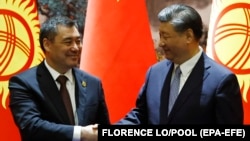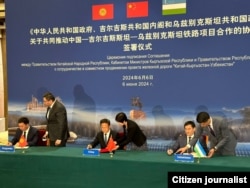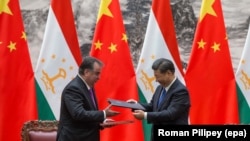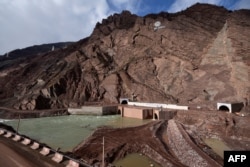ALMATY, Kazakhstan -- For most of the last two decades, China has been the most obvious source of foreign direct investment for the countries of Central Asia.
But for the two poorest countries of the region -- Kyrgyzstan and Tajikistan -- truly strategic investment from Beijing appeared to peak in the middle of that period.
That was when Chinese companies agreed on deals to overhaul the transport and energy infrastructure in the two mountainous countries, build or modernize power plants in their respective capitals, and acquire lucrative mineral deposits along the way.
These deals were most often backed with loans from Chinese state banks and carried the logic of Beijing’s mammoth Belt and Road Initiative (BRI), despite some of them predating Chinese leader Xi Jinping’s 2013 unveiling of that vision.
But more recently there has been something of a lull -- or at least an absence of eye-catching deals by Beijing for major projects.
Recent official rhetoric suggests that Kyrgyzstan and Tajikistan are eyeing fresh investment splurges from China, with one of those projects -- the multibillion dollar China-Kyrgyzstan-Uzbekistan (CKU) railway -- rivaling some of Beijing’s largest projects in the region.
That is all positive, but can they enjoy a new wave of investment and avoid the “debt trap” that has become part of the BRI narrative in other countries around the world?
CKU Railway Finally On Track?
In the years immediately after Kyrgyzstan’s second revolution in 2010, hundreds of millions of Chinese foreign direct investment (FDI) poured into the country.
One of the most obvious successes of this drive was the Datka-Kemin power transmission line, a $400 million project unifying the country’s northern and southern electricity grids that was completed in 2015. After that, there was a drop off.
While some analysts blamed this on chronic security issues in Kyrgyzstan -- a particular drag on the mining sector -- it is also true that Chinese investment had fulfilled many of the government’s top priorities in terms of national-level projects.
One idea that remained little more than a discussion since it was first conceived in the 1990s was the CKU railway, which supporters see as a game changer in intercontinental overland trade.
The link has the potential to become an even faster rail route connecting Chinese and European markets than the routes that go through Kazakhstan, Russia, and Belarus.
In an interview with RFE/RL’s Kyrgyz Service this month, Central Asia-focused researcher Davide Cancarini argued that CKU’s urgency for Beijing has grown notably as the more traditional route loses its appeal due to the increased sanctions risk connected to Russia’s war in Ukraine.
Although the route remains operational for the moment, “for China, it has become important to find routes between East and West that don’t traverse Russia,” Cancarini noted.
This same logic has also seen a boost in interest and investment in the so-called Middle Corridor, a route connecting China though Kazakhstan to the Caucasus and onto the large European Union single market.
Still, the roughly 300-kilometer Kyrgyz leg of the railway has always looked rather expensive due to the extreme technical challenges through mountainous territory.
And that is why the latest three-way meeting with the heads of state of the three countries present -- via video link -- in Beijing on June 6 had the feel of a breakthrough.
“The transport ministers of [Uzbekistan and Kyrgyzstan] and the chairman of the State Committee for Development and Reform of China have signed [the agreement], financial models are approved, money has been found, and we plan to begin construction in August,” trumpeted Akylbek Japarov, chairman of the Kyrgyz Cabinet of Ministers one week after the meeting.
But the idea that “money has been found” deserves further scrutiny.
The agreement reached in Beijing and subsequently disclosed by Kyrgyzstan’s unicameral legislature, the Jogorku Kenesh, is significant in that it offers details about the divisions of financial responsibility.
According to the document, the three trio will form a joint company in which China will hold a 51 percent stake while Uzbekistan and Kyrgyzstan will be responsible for 24.5 percent each.
The conundrum lies in the fact that even official Kyrgyz estimates for the cost of its part of the track vary from $4.5 billion to $8 billion, with Japarov himself voicing the upper figure.
Moreover, the agreement states that the project will operate under a BOT (build–operate–transfer) structure to be agreed to between Kyrgyzstan and the joint company where China has full control.
The BOT principle should -- in theory -- protect Kyrgyzstan from excessive debt exposure but it may have to forfeit at least part of the revenue the railway generates from transit fees until it has covered its own building costs.
And those could well increase further, given that the project will involve building around 50 tunnels and 90 bridges, in some cases at altitudes of 3,000 meters.
Kyrgyz President Sadyr Japarov (no relation to Akylbek Japarov) said at the June 6 event that transit could bring $200 million annually into his country's coffers.
Official estimates for Kyrgyzstan’s contribution begin at almost $600 million. That is most likely to be met in the form of a Chinese loan, whose conditions are unknown.
But at least Beijing’s political will is clear.
Kyrgyz media reported this month that China’s Foreign and Commerce ministries had lowered the Central Asian country’s risk rating to medium, leaving only “high-risk” ratings for two of the country's seven provinces that the track will not go through.
The CKU railway is by far the largest and most intriguing potential project involving China and Kyrgyzstan.
But an increasingly confident administration in Bishkek is also hopeful that Beijing will revive others.
In October, Akylbek Japarov said Bishkek was hoping for Chinese assistance in building Kambarata-1, a $3 billion, 2,000-megawatt hydropower project on the Naryn River.
He also mentioned the much smaller-scale Upper Naryn hydropower cascade, priced at more than $700 million over a decade ago.
Both projects were originally slated for Russian investors before Bishkek tore up the deals, citing a lack of progress.
Speaking on June 20 in parliament, Akylbek Japarov said that projects like Kambarata-1 and the China-led railway would put Kyrgyzstan's development on "a different trajectory," and likened President Japarov to Russia's visionary monarch Peter the Great.
The cabinet chief also denied that either project would increase the state debt, since they are being carried out "as part of a public-private partnership," but offered no further details.
In August, Japarov held talks with China’s ambassador to Bishkek, Du Duwen, over Beijing’s potential investment in yet another hydropower facility on the Sary-Jaz River in the eastern province of Issyk-Kul. The idea for that six-bloc, 1,100 megawatt facility dates back to the Soviet period.
Tajikistan’s Billion-Dollar Solar Savior?
Chinese investments are very much in the news in Tajikistan these days, too.
On June 21, Chinese investors at a forum in Dushanbe made pledges of over $500 million, according to the State Committee for Investment and Property Management of Tajikistan.
They included promised investment for an iron-ore processing plant in the northern city of Khujand, the modernization of one of the capital’s main stadiums, and the purchase of Chinese electric cars for local taxi services.
This is standard fare for a country that the U.S. State Department called “saturated in opaque loans connected” to China’s BRI and dependent on Beijing for more than “99.8 percent” of FDI in a 2023 investment climate statement.
More eyebrow-raising is the apparent $1.5 billion commitment of a Chinese company to building a solar power plant near Tajikistan’s border with Afghanistan.
The investment revealed in late May by Tajikistan’s Economic Development Ministry is envisaged in four stages, with the first costing a mere $150 million with a capacity of 150 megawatts.
But if completed it would dwarf the investments made by China in other Tajik plants, such as the Dushanbe-2 power plant, commissioned in 2016, that cost $350 million.
The power needs in Tajikistan -- where severe brownouts are common -- are well known.
The World Bank estimated in 2013 that winter energy shortages alone cost the country more than $200 million -- 3 percent of gross domestic product -- each year. They remain chronic.
Yet the latest round of Chinese investment comes at a time when Tajikistan’s debt repayments are increasing.
Dushanbe’s obligations to the Export-Import Bank of China are the largest to any single creditor, standing at $900 million, down from nearly $1.4 billion in early 2022, while the grace period for a series of loans from this bank ends in 2025, according to the Tajik Finance Ministry.
Combined with the expected full repayment of a $500 million Eurobond issued at a rate of more than 7 percent in 2027, this means that the cost of servicing the country’s multibillion dollar external debt will more than double in the coming years.
The proceeds from the Eurobond sale were earmarked for the Roghun megadam, a major weight on the national budget that officials estimate will require another $5 billion to finish.
And China, too, is backing this project -- set to be the tallest in the world -- albeit via a financial institution where it has a privileged role.
In May of last year, Tajikistan’s presidential administration said the Asian Infrastructure Investment Bank, where Beijing holds more than 30 percent of the shares and has a voting stake of at least 26.5 percent, had pledged its own $500 million loan for Roghun.
















